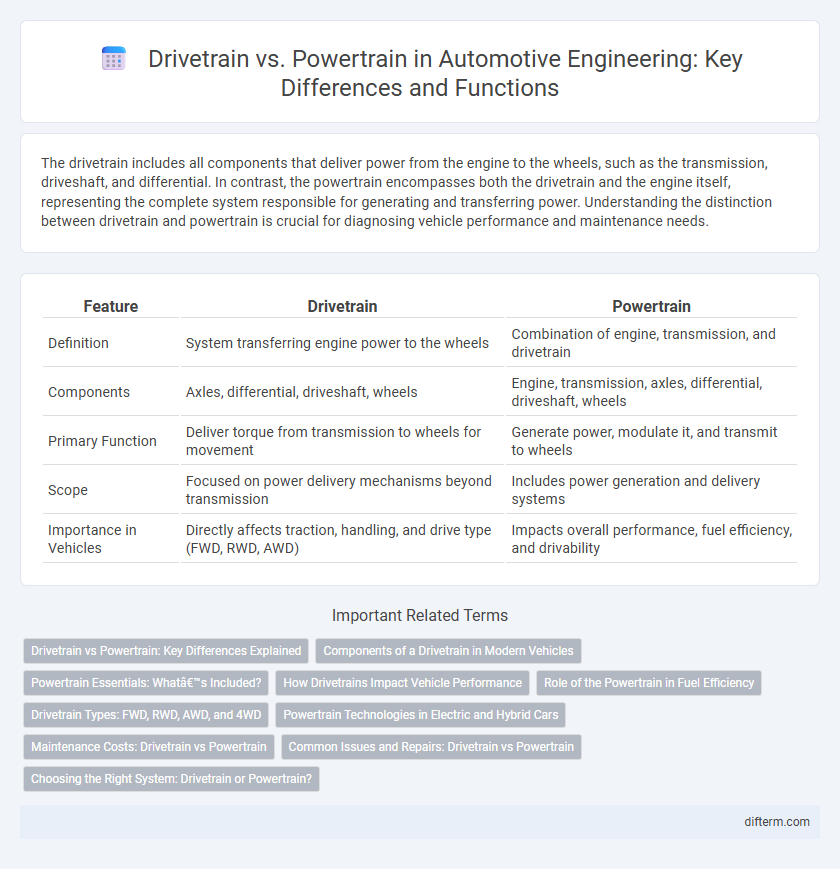The drivetrain includes all components that deliver power from the engine to the wheels, such as the transmission, driveshaft, and differential. In contrast, the powertrain encompasses both the drivetrain and the engine itself, representing the complete system responsible for generating and transferring power. Understanding the distinction between drivetrain and powertrain is crucial for diagnosing vehicle performance and maintenance needs.
Table of Comparison
| Feature | Drivetrain | Powertrain |
|---|---|---|
| Definition | System transferring engine power to the wheels | Combination of engine, transmission, and drivetrain |
| Components | Axles, differential, driveshaft, wheels | Engine, transmission, axles, differential, driveshaft, wheels |
| Primary Function | Deliver torque from transmission to wheels for movement | Generate power, modulate it, and transmit to wheels |
| Scope | Focused on power delivery mechanisms beyond transmission | Includes power generation and delivery systems |
| Importance in Vehicles | Directly affects traction, handling, and drive type (FWD, RWD, AWD) | Impacts overall performance, fuel efficiency, and drivability |
Drivetrain vs Powertrain: Key Differences Explained
The drivetrain consists of components that deliver power from the transmission to the wheels, including the driveshaft, differential, and axles. The powertrain encompasses the engine, transmission, and drivetrain, representing the entire system that generates and transmits power to move the vehicle. Understanding the distinction is crucial for diagnosing vehicle performance and maintenance, as powertrain covers all elements producing and transferring power, while the drivetrain focuses specifically on the delivery mechanisms to the wheels.
Components of a Drivetrain in Modern Vehicles
The drivetrain in modern vehicles encompasses all components that transfer power from the transmission to the wheels, including the driveshaft, differential, axles, and CV joints. These parts work together to ensure efficient torque delivery and smooth vehicle movement across various driving conditions. Unlike the powertrain, which includes the engine and transmission, the drivetrain specifically focuses on the mechanical systems that propel the vehicle forward.
Powertrain Essentials: What’s Included?
The powertrain encompasses all components that generate power and deliver it to the road, including the engine, transmission, driveshaft, differentials, and axles. Unlike the drivetrain, which excludes the engine, the powertrain integrates both the engine and drivetrain elements essential for vehicle motion. Understanding powertrain essentials is crucial for diagnosing performance issues and improving fuel efficiency in automotive systems.
How Drivetrains Impact Vehicle Performance
Drivetrains significantly influence vehicle performance by determining the distribution of power from the engine to the wheels, affecting acceleration, traction, and handling. Different drivetrain configurations such as front-wheel drive, rear-wheel drive, and all-wheel drive optimize power delivery for various driving conditions and performance needs. Efficient drivetrain systems reduce energy loss, enhance fuel economy, and improve overall driving dynamics in automotive design.
Role of the Powertrain in Fuel Efficiency
The powertrain, encompassing the engine, transmission, and drivetrain components, plays a critical role in optimizing fuel efficiency by managing how power is generated and transmitted to the wheels. Advanced powertrain technologies, such as direct fuel injection, turbocharging, and continuously variable transmissions (CVTs), enhance combustion efficiency and reduce energy losses. Implementing hybrid and electric powertrain systems further improves fuel economy by recovering energy and minimizing reliance on internal combustion engines.
Drivetrain Types: FWD, RWD, AWD, and 4WD
Drivetrains are categorized into Front-Wheel Drive (FWD), Rear-Wheel Drive (RWD), All-Wheel Drive (AWD), and Four-Wheel Drive (4WD), each offering distinct performance characteristics suited for various driving conditions. FWD systems power the front wheels, enhancing fuel efficiency and handling in everyday driving, while RWD sends power to the rear wheels, favored for sportier, performance-oriented vehicles. AWD continuously powers all four wheels for improved traction on diverse surfaces, whereas 4WD, often found in trucks and off-road vehicles, provides selectable engagement of all wheels for rugged terrain and heavy-duty use.
Powertrain Technologies in Electric and Hybrid Cars
Powertrain technologies in electric and hybrid cars integrate advanced components such as electric motors, battery packs, and regenerative braking systems that optimize energy efficiency and performance. Unlike traditional drivetrains focused on mechanical power transfer, electric powertrains rely heavily on electronic control units and power converters to manage torque distribution seamlessly. Innovations in powertrain technology, including solid-state batteries and intelligent energy management software, enhance driving range and reduce emissions in modern electric and hybrid vehicles.
Maintenance Costs: Drivetrain vs Powertrain
Drivetrain maintenance costs typically involve components such as the transmission, driveshafts, and differentials, which can vary depending on vehicle type and usage intensity. Powertrain maintenance encompasses all drivetrain elements plus the engine, often resulting in higher overall expenses due to more complex repairs and routine servicing like oil changes and timing belt replacements. Understanding the distinction helps in budgeting for repairs, as powertrain maintenance generally incurs greater costs compared to drivetrain-specific issues.
Common Issues and Repairs: Drivetrain vs Powertrain
Common issues in drivetrains include worn-out differential gears, damaged CV joints, and failing drive shafts, often requiring repairs like joint replacement or gear realignment. Powertrain problems frequently stem from engine malfunctions, transmission failures, and faulty sensors, necessitating extensive diagnostics and component rebuilding or replacement. Understanding these distinctions helps prioritize maintenance and repair strategies to optimize vehicle performance and longevity.
Choosing the Right System: Drivetrain or Powertrain?
Selecting the right system between drivetrain and powertrain depends on vehicle performance goals and maintenance priorities; the drivetrain encompasses components transferring power from the engine to the wheels, while the powertrain includes the engine, transmission, and drivetrain. For enhanced fuel efficiency and smoother operation, a comprehensive powertrain system with advanced transmission technologies is ideal. In contrast, focusing on drivetrain components like differential types and axle configurations can optimize handling and traction for specific driving conditions.
Drivetrain vs Powertrain Infographic

 difterm.com
difterm.com